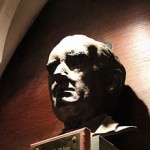 Dreams play a significant role in The Lord of the Rings, J.R.R. Tolkien’s multi-part fantasy story written in the first half of the 20th century. The dream elements become muted in Peter Jackson’s film adaptation, but in the novels they serve as an important source of insight for the characters. According to Curt Hoffman in “Wings over Numenor: Lucid Dreaming in the Writing of J.R.R. Tolkien,” the dreams in the stories were modeled in many cases after Tolkien’s own dream experiences. For instance, the Middle Earth legend of Numenor, a western land that was destroyed by a vast ocean wave, apparently derives from Tolkein’s personal “Atlantis Complex” and his recurrent dreams of huge, all-consuming waves.
Dreams play a significant role in The Lord of the Rings, J.R.R. Tolkien’s multi-part fantasy story written in the first half of the 20th century. The dream elements become muted in Peter Jackson’s film adaptation, but in the novels they serve as an important source of insight for the characters. According to Curt Hoffman in “Wings over Numenor: Lucid Dreaming in the Writing of J.R.R. Tolkien,” the dreams in the stories were modeled in many cases after Tolkien’s own dream experiences. For instance, the Middle Earth legend of Numenor, a western land that was destroyed by a vast ocean wave, apparently derives from Tolkein’s personal “Atlantis Complex” and his recurrent dreams of huge, all-consuming waves.
Hoffman’s chapter appears in Lucid Dreaming: New Perspectives on Consciousness in Sleep, which Ryan Hurd and I edited for ABC-Clio. Hoffman explains that the most remarkable story Tolkien ever wrote about dreams was also the only story he ever wrote set in the future, not in the past. Titled “The Notion Club Papers,” Tolkien started it in 1946 but never finished the manuscript. Hoffman says,
“The work purports to be the minutes of the fortnightly meetings of an Oxford literary society, the Notion Club (obviously a gloss for the Inklings [Tolkien’s actual literary club], although there is little one-for-one correspondence to its members), between 1980 and 1990. The manuscript’s conceit is that the papers “were found after the Summer Examinations of 2012, on the top of one of a number of sacks of waste paper in the basement of the Examinations Schools at Oxford by the present editor,” and it is represented to have been published in 2014.” (133)
Tolkien creates a strangely forward-telescoping, prospectively recursive way of framing the story—he writes about events that happen 40 years in the future, which are then discovered 20+ years after that, and are then published two years after that (at a time that happens to be our present).
In the story the club members engage in lengthy discussions of dreaming as a means of space and time travel, along with various accounts of strange adventures in thought and consciousness. Without warning the discussion turns rather apocalyptic, as several club members describe visions that portend the coming of cataclysmic storms. The manuscript breaks off there, and Tolkien never went back to it. After careful study of this work, Hoffman concludes,
“It is entirely unclear what purpose Tolkien had in producing the Notion Club Papers, but his publishers were pressuring him at the time to get back to the writing of The Lord of the Rings, for obvious economic reasons, and this may explain why he did not finish the work. He never returned to it, and its status remains mysterious to this day. However, it is the clearest indication we have in all his writing of his interest in a variety of dream states and their relationship to waking physical reality. In particular, even though there is no evidence that he was aware of the writings of van Eeden on lucidity, it seems that Tolkien had a strong interest in lucid dreaming, based upon his own personal experience, and that he was attempting to put this into some kind of formulation in words that would make his experience more understandable, at least to his fellow Inklings.” (138)
